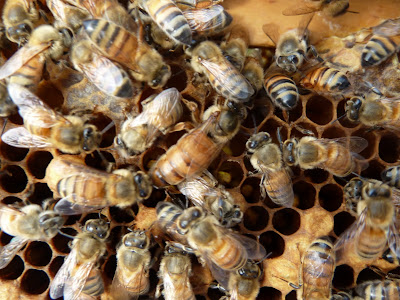Split Hive:
As I came upon the split hive I immediately noticed a cloud of bees swirling around the outside of the hive. Instantly odd since the population was so low that even basic in and out traffic was not very prolific. The other thing that was odd was the majority of the cloud of bees were attempting to enter the hive under the telescoping cover instead of the actual entrance. These were all signs that the hive was in the process of being robbed. When a strong hive finds a weak hive that cannot defend the supply of honey they have, then they overpower the guard bees and steal the honey. Not a good situation since bees are killed during the fighting and the weak hive can either be greatly damaged or destroyed.
Here is a photo of what a honey frame looks like when it has been robbed. The cells have been torn open during the frantic raiding and have a very jagged appearance.
 |
| Robbed Frame |
Upon opening the hive it was obvious to me that the only bees present were the ones robbing out the honey. There was very little honey left in any of the frames and I quickly went through both boxes looking for any sign of the virgin queen that was spotted two inspections ago or any sign of eggs or larvae. She was no where to be found and the small cluster of about 50 dead bees on the bottom board told me that if I did find her, she would probably be amongst the dead. I combed through the dead bees and did not find her. I did find a dead yellow jacket and a bee with its stinger and venom sac exposed. No doubt, she died in battle.
With nothing else left to do with the split hive (or ex-split hive), I decided to add the now mostly empty brood box onto White Hive.
White Hive:
My goal this time with White Hive is to verify that what I thought might have been eggs really were freshly laid eggs. As you may recall, I spotted the queen during my last inspection. If she was from the queen cell I installed, I wouldn't have known for sure that she had flown out and successfully mated. If I find eggs that tells me that she did.
The first few frames were honey with some pollen as I expected, but as I pulled frame 4 I hit the jackpot.
 |
| Larvae! |
On the other side of frame 4 I was able to spot a baby bee emerging from her cell (dead center), some very tiny larvae (two cells down to the left) and what looks like a tiny grain of rice......an egg (one cell down to the left and another one two cells down to the right)!
 |
| Eggs and Larvae |
Continuing on, I found what I think was one of the old Queen Cups that the bees decided they do not need anymore. They look like they are in the process of tearing it down.
The remaining frames had more honey, pollen, open larvae, capped larvae and a small patch of drone brood that is just about to hatch on frame 7. White Hive looks really good and with a new Queen going full bore, they should be very strong going into Winter.
Speaking of changing seasons, I saw some Goldenrod in bloom. That sure heralds the end of summer doesn't it? Lame!
Until next time, thanks for reading!






